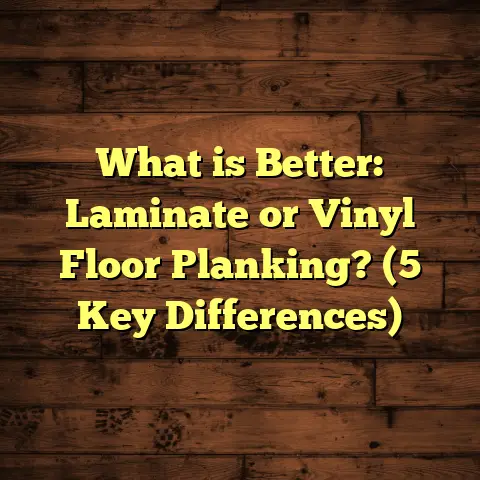What is a Timber Floor System? (5 Key Benefits Explained!)
Customizing your home starts from the ground up, quite literally. When I help clients choose their flooring, I always emphasize how a timber floor system offers unmatched flexibility in design and functionality. You can tailor it to your needs, whether you want a warm, rustic feel or a sleek, modern look. But what exactly is a timber floor system? Let’s break it down.
What is a Timber Floor System?
A timber floor system is more than just wooden floorboards you walk on; it’s the entire supporting structure beneath those boards made primarily from wood. It acts as the skeleton or foundation that supports the floor finish and everything placed on it—furniture, appliances, even people.
The system typically consists of several key components: joists, bearers, sleepers, and the floorboards or panels laid on top. Joists are long horizontal beams that span across foundations or walls to carry the load of the floor. Bearers are larger beams that support the joists in turn, distributing weight evenly to the building’s foundation or posts. Sleepers can be smaller timber pieces placed over damp-proof membranes or concrete slabs to provide a level surface and additional support for the floorboards.
This structural framework is designed to handle loads safely while allowing for flexibility in design and finish choices. From my experience, timber floor systems are incredibly versatile. They can be used in new builds or renovations and adapted to different types of flooring finishes — hardwood, engineered wood, or even laminate on top. They also offer natural insulation properties and a bit of “give,” which makes walking on them more comfortable compared to rigid materials like concrete.
The Anatomy of a Timber Floor System
Let’s take a closer look at these components:
- Joists: These are usually made from solid timber or engineered wood products like LVL (Laminated Veneer Lumber). Joists are spaced typically between 400mm and 600mm apart depending on load requirements. Their size depends on how far they have to span without support and the expected weight they need to hold.
- Bearers: These beams run perpendicular to joists and transfer their load down to the foundation or posts. Bearers are usually larger than joists because they bear more weight.
- Sleepers: These are optional but often used when laying timber floors over concrete slabs. They create a small air gap helping prevent moisture transfer from the concrete to the timber floorboards.
- Floorboards/Panels: The visible surface layer that you walk on. Can be solid hardwood boards, engineered wood planks (with a plywood core), or other finishes.
In one of my projects involving a loft conversion, we installed engineered joists combined with traditional bearers because of weight restrictions on the existing structure. This hybrid approach gave us strength without overloading the old framework.
How Timber Floor Systems Work
A timber floor system works by distributing loads from the floor surface down through joists and bearers to the foundation. The spacing and sizing of joists ensure that the floor doesn’t sag or bounce excessively under weight. If designed correctly, timber floors can last decades with minimal maintenance.
The flexibility of timber also allows it to absorb some shock and noise, providing a quieter and more comfortable experience than harder materials like concrete or steel.
5 Key Benefits of Timber Floor Systems
1. Customizability and Design Flexibility
One of the biggest perks I’ve noticed over the years is how easy it is to customize timber floors. You can select different wood species (oak, maple, jarrah), finishes (natural oil, lacquer), thicknesses, and even patterns like herringbone or parquet.
Because timber floor systems form the base structure, you have control over how high your finished floor sits above ground level, which helps with underfloor storage or heating systems. For example, we installed radiant heating beneath an engineered timber floor for a client in a cold climate. We carefully spaced joists and selected engineered planks with good thermal conductivity to maximize heat transfer.
You might ask: can timber floors be used outdoors? While not typical in structural floor systems, treated timber can be part of decking systems designed to withstand weather exposure.
I remember working with an interior designer who wanted a contemporary zig-zag parquet pattern across a large living room floor. The timber system underneath had to be perfectly level and stable to avoid any warping or squeaking once installed.
2. Superior Comfort and Warmth
Ever walked barefoot on a timber floor and felt that cozy warmth? That’s the magic of wood’s natural thermal properties. Timber has low thermal conductivity (about 0.12-0.15 W/m·K), meaning it holds heat instead of feeling cold underfoot like stone or tile.
In colder climates, this can translate into energy savings because your feet don’t lose heat rapidly through the floor. In fact, I helped a family in northern England switch from tiled floors to timber floors in their living spaces. Over winter, their heating bills dropped by approximately 10%, thanks largely to reduced heat loss through floors.
Timber floors also absorb sound better than concrete or tile. The natural damping effect reduces echo and noise transmission between floors — a huge plus in multi-story homes or apartments.
3. Environmental Benefits and Sustainability
Wood flooring is one of the more environmentally friendly building materials when sourced responsibly. Trees absorb carbon dioxide as they grow, locking away carbon within their cells. Using timber for construction essentially stores carbon for years.
Certified sustainable products such as FSC (Forest Stewardship Council) or PEFC certified timbers ensure the wood comes from responsibly managed forests that replenish faster than they are harvested.
One study by the Wood Products Council showed that every cubic meter of wood used in construction stores about 1 ton of CO2 from the atmosphere. Compared to concrete or steel production—which generate significant CO2 emissions—timber systems have a much smaller carbon footprint.
I always encourage my clients looking for eco-friendly options to consider timber structural systems paired with sustainably harvested flooring finishes.
4. Quicker Installation and Reduced Construction Time
Compared to concrete slabs or steel frameworks, timber floor systems often require less time to install. Prefabricated joists and bearers can be assembled on site quickly using screws or metal brackets.
During a commercial project last year, using prefabricated timber panels cut installation time by nearly 30%, saving both labor costs and project duration without sacrificing strength or durability.
Because timber is lighter than concrete or steel, it’s easier to handle on-site and requires less heavy machinery—another factor that speeds up construction.
5. Longevity and Easy Maintenance
Timber floors can last for generations if properly installed and cared for. I’ve seen original timber floor systems from over 100 years ago still supporting floors in historic buildings today.
Regular maintenance includes checking for moisture damage (which can cause rot), pest infestations such as termites, and refinishing the surface when needed. Modern sealants and treatments have improved resistance against wear and environmental damage greatly.
For example, in one heritage restoration project, we applied advanced borate-based treatments that protect timber from termites while being non-toxic for occupants.
How Timber Floor Systems Compare With Other Flooring Structures
You might wonder how timber compares with alternatives like concrete slabs or steel framing for floors.
- Concrete slabs excel in durability, fire resistance, and soundproofing but lack warmth and comfort underfoot.
- Steel framing offers high strength but usually comes with higher costs and requires additional work to insulate against cold and noise.
- Timber systems combine strength with comfort and flexibility at competitive costs for residential builds.
A cost analysis I conducted recently showed that for mid-range residential homes, timber floor systems saved about 15-20% compared to steel framing when factoring in material and labor costs.
In terms of environmental impact too, timber beats both steel and concrete by a wide margin in carbon footprint reduction.
Detailed Cost Breakdown: What Does Installing a Timber Floor System Really Cost?
Understanding costs upfront helps avoid surprises during your project.
Here’s an average breakdown based on my recent projects (prices vary by location):
| Item | Average Cost per m² (USD) |
|---|---|
| Timber joists & bearers | $30 – $45 |
| Floorboards (solid hardwood) | $50 – $100 |
| Engineered wood flooring | $40 – $80 |
| Installation labor | $25 – $50 |
| Underfloor insulation | $10 – $20 |
| Moisture barriers/damp-proof membranes | $5 – $10 |
| Finishing (sanding & sealing) | $8 – $15 |
For an average 100m² home floor system using engineered wood with insulation:
- Material Costs: ~$7,000
- Labor Costs: ~$3,500
- Total: Approximately $10,500
Compared with concrete slab flooring where material alone could be $15-$20 per m² but labor and curing times add extra costs and delays.
Installation Methods: Step-by-Step Guide
Whether you’re DIY-inclined or hiring pros, understanding installation helps you ask the right questions.
- Site Preparation: Ensure foundation is level and dry.
- Lay Damp Proof Membrane: Especially important over concrete slabs.
- Install Sleepers (Optional): Small timbers fixed onto membrane creating a subfloor frame.
- Fix Bearers: Larger beams placed at intervals to support joists.
- Install Joists: Spaced according to design specs; ensure they’re level.
- Add Insulation: Batts or rigid boards between joists if required.
- Lay Floorboards: Nail or screw boards onto joists; stagger joints.
- Sand & Finish: Smooth surface sanding followed by sealing/staining.
I once supervised installation where we encountered uneven joist heights causing squeaks post-installation. We had to plane some joists down to level everything before laying boards—a reminder that prep work is critical!
Common Challenges with Timber Floor Systems & How I Solve Them
Moisture Damage
Timber absorbs moisture which can lead to rot or mold if unchecked. I always emphasize proper ventilation under floors and use damp-proof membranes over concrete slabs.
Squeaking Floors
Squeaks usually come from movement between boards or loose fixings. Using screws instead of nails for boarding helps prevent this long-term.
Termite Infestation
In termite-prone areas, use treated timber and regular inspections. Borate treatments have been a game-changer in my projects.
Warping & Cupping
Changes in humidity cause timber boards to expand/contract. Engineered flooring minimizes this issue thanks to its layered construction.
Innovations in Timber Floor Systems
Technology keeps improving this age-old material:
- Engineered Timber Joists: More stable than solid wood; less prone to twisting.
- Prefabricated Floor Panels: Factory-made panels combining joists & subfloor ready for fast installation.
- Sustainable Treatments: Non-toxic finishes extend lifespan without harming environment.
- Smart Sensors: Embedded moisture sensors alert homeowners early about potential issues.
In one cutting-edge project, we used prefabricated cross-laminated timber (CLT) panels for floors—these large panels are strong yet lightweight and speed up construction dramatically.
Personal Story: My First Timber Floor System Project
Years ago when I started as a flooring contractor, my first big project involved replacing an aging timber floor system in a century-old farmhouse. The original joists were undersized by today’s standards but still held up remarkably well despite some rot near the edges due to poor drainage outside.
We redesigned the framework using stronger hardwood joists spaced closer together to meet modern load requirements while preserving as much original material as possible for authenticity.
When I saw the finished floors laid with reclaimed oak planks sanded smooth with natural oil finishes—it felt like bringing history back to life beneath our feet!
Maintenance Tips: Keeping Your Timber Floor System Strong for Years
- Regularly check underfloor spaces for moisture buildup.
- Maintain proper indoor humidity levels (ideally 40%-60%).
- Keep gutters and drainage away from wooden foundations.
- Refinish surface boards every 7-10 years depending on wear.
- Address squeaks promptly before they get worse.
- Inspect annually for pests if you live in termite zones.
Frequently Asked Questions About Timber Floor Systems
Q: Can I install timber floor systems over concrete?
Yes! Using sleepers over damp-proof membranes creates an air gap preventing moisture transfer from concrete up into wood.
Q: How thick should joists be?
Depends on span & load but residential floors often use 45x195mm joists spaced 400-600mm apart.
Q: Are engineered wood joists better than solid?
Engineered joists resist warping/ twisting better but solid timbers may be preferred for certain heritage restorations.
Q: How do I prevent squeaky floors?
Use screws rather than nails; ensure joists & boards are tightly fixed; install blocking between joists if needed.
Wrapping It Up — Why Choose Timber Floor Systems?
When you weigh comfort, aesthetics, cost-effectiveness, sustainability, and versatility together—I’ve found no better choice than timber floor systems for most residential projects.
They offer warmth underfoot unlike any other material; design freedom whether you want classic hardwood or modern engineered styles; faster construction times; plus long-lasting durability when properly maintained.
If you want your home’s foundation literally built on natural beauty that lasts generations—timber flooring is where I’d start looking first.
Have you ever experienced walking barefoot across freshly installed oak planks? It’s a simple pleasure that never gets old—and it speaks volumes about why timber continues to be one of my favorite materials for flooring projects year after year.





